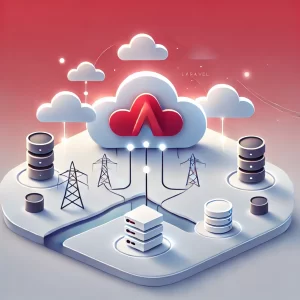Introduction
The cloud-native paradigm is reshaping how applications are developed, deployed, and managed. Laravel, with its elegant and feature-rich framework, is well-suited for leveraging cloud-native features. This article explores how Laravel integrates seamlessly with cloud-native technologies to build scalable, resilient, and high-performing applications.
What Does Cloud-Native Mean?
Cloud-native refers to building and running applications that fully exploit the advantages of the cloud computing model.
Key Characteristics of Cloud-Native Applications
- Microservices Architecture: Applications broken into smaller, independent services.
- Containerization: Use of Docker and Kubernetes for consistent environments.
- Scalability: On-demand scaling of resources.
- Resiliency: High availability with fault tolerance.
Why Laravel is Ideal for Cloud-Native Applications
Laravel’s features make it a great choice for cloud-native development:
- Dependency Management: Composer simplifies package management.
- Scalability: Laravel queues and caching work seamlessly with cloud platforms.
- API-First Approach: Supports RESTful and GraphQL APIs for microservices.
- Integration: Easily integrates with cloud platforms like AWS, Google Cloud, and Azure.
Building Cloud-Native Applications with Laravel
1. Containerizing Laravel with Docker
Containerization ensures consistent development and production environments.
- Dockerfile Example:
FROM php:8.1-fpm WORKDIR /var/www COPY . . RUN docker-php-ext-install pdo pdo_mysql CMD ["php-fpm"] - Use Docker Compose to orchestrate services:
services: app: build: . ports: - "8000:8000" volumes: - .:/var/www
2. Implementing Microservices with Laravel
Split your application into smaller services:
- Example: Use Laravel for the core API and Node.js for real-time services.
- Communicate between services using queues like SQS or RabbitMQ.
3. Scaling with Kubernetes
Deploy and manage Laravel containers using Kubernetes:
- Write a Kubernetes deployment YAML:
apiVersion: apps/v1 kind: Deployment metadata: name: laravel-app spec: replicas: 3 selector: matchLabels: app: laravel template: metadata: labels: app: laravel spec: containers: - name: laravel image: laravel-app:latest
4. Using Cloud Databases
Move your database to the cloud for better performance:
- Options: AWS RDS, Google Cloud SQL, Azure SQL Database.
- Update
.env:DB_CONNECTION=mysql DB_HOST=<cloud-host> DB_PORT=3306 DB_DATABASE=<db-name> DB_USERNAME=<username> DB_PASSWORD=<password>
5. Implementing Caching with Cloud Services
Integrate caching services like AWS ElastiCache or Redis Cloud:
Cache::store('redis')->put('key', 'value', $seconds);
Advanced Cloud-Native Features
1. Serverless Functions
Use Laravel Vapor to deploy Laravel applications as serverless functions on AWS Lambda.
2. CI/CD Pipelines
Automate testing and deployment with tools like GitHub Actions:
name: Laravel CI/CD
on:
push:
branches:
- main
jobs:
build:
runs-on: ubuntu-latest
steps:
- uses: actions/checkout@v2
- uses: shivammathur/setup-php@v2
with:
php-version: 8.1
- run: composer install
- run: php artisan test
3. Monitoring and Logging
Use cloud-native monitoring tools like AWS CloudWatch, Datadog, or New Relic to track application performance and logs.
Comparative Table: Cloud-Native Features in Laravel
| Feature | Cloud Service | Laravel Tool/Integration |
|---|---|---|
| Scalability | Kubernetes, AWS ECS | Docker, Laravel Vapor |
| Caching | AWS ElastiCache | Redis Integration |
| Database | Google Cloud SQL | Eloquent ORM |
| Queues | AWS SQS, RabbitMQ | Laravel Queues |
| Monitoring | Datadog, CloudWatch | Laravel Telescope, Monolog |
Key Takeaways
- Cloud-native development enhances Laravel applications’ scalability and resilience.
- Tools like Docker, Kubernetes, and Laravel Vapor simplify cloud integration.
- Continuous monitoring ensures optimized performance in cloud environments.
FAQs
Q1: What is the advantage of using Laravel for cloud-native applications?
Laravel provides robust tools for API development, scalability, and integration with cloud services.
Q2: Can Laravel work with serverless architectures?
Yes, Laravel Vapor enables serverless deployment on AWS Lambda.
Q3: How does containerization help Laravel applications?
Containerization ensures consistent environments, simplifies scaling, and accelerates deployment.
Q4: Is Kubernetes mandatory for cloud-native Laravel applications?
No, Kubernetes is optional but recommended for managing containerized workloads.
Q5: Can Laravel handle real-time features in cloud-native apps?
Yes, using WebSockets, Pusher, or queues, Laravel can efficiently manage real-time data.
Conclusion
Laravel’s compatibility with cloud-native features positions it as a versatile framework for modern application development. By leveraging tools like Docker, Kubernetes, and Laravel Vapor, developers can build scalable, resilient, and high-performing applications tailored to the cloud.
For further insights, explore the Laravel Documentation and Docker Documentation.


